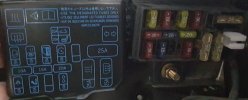I've bought a A118C (Australian temp) and am planning to hardwire 2 USB ports and then run cables, one for the A118C and another for mobile phone use.
I can solder, but knowledge of electrical things is at 0, knowledge currently from reading on other peoples installs. Didn't even know what a Ferrite Core and Ring Terminal were called till now.
Iulian posted what looks to be almost exactly what I want here.
https://dashcamtalk.com/forum/threa...wire-any-dashcam-no-experience-required.7712/

List of items to purchase
Dual 2 USB DC-DC Car Charger Converter Module 12V To 5V 3A 15W Power Adapter New
15ft USB 2.0 A Male to Mini-B 5pin Male 28/24AWG Cable w/ Ferrite Core (Gold Plated)
10ft USB 2.0 A Male to Micro 5pin Male 28/24AWG Cable w/ Ferrite Core (Gold Plated)
New 1X ATM APM Circuit Fuse Tap Piggy Back MINI Blade Fuse Holder 15A ACS 12V
5 pcs 5A 5AMP Mini Size Blade Type Car Fuse Auto Cars & Trucks Fuses New
Ring RED Insulated wire Crimp Terminal Connector AWG16-22 #AU
Questions

Just realised I don't have a crimper as shown in this video
How To Hardwire a Dashcam Simple Easy Steps
I can solder, but knowledge of electrical things is at 0, knowledge currently from reading on other peoples installs. Didn't even know what a Ferrite Core and Ring Terminal were called till now.
Iulian posted what looks to be almost exactly what I want here.
https://dashcamtalk.com/forum/threa...wire-any-dashcam-no-experience-required.7712/

List of items to purchase
Dual 2 USB DC-DC Car Charger Converter Module 12V To 5V 3A 15W Power Adapter New
15ft USB 2.0 A Male to Mini-B 5pin Male 28/24AWG Cable w/ Ferrite Core (Gold Plated)
10ft USB 2.0 A Male to Micro 5pin Male 28/24AWG Cable w/ Ferrite Core (Gold Plated)
New 1X ATM APM Circuit Fuse Tap Piggy Back MINI Blade Fuse Holder 15A ACS 12V
5 pcs 5A 5AMP Mini Size Blade Type Car Fuse Auto Cars & Trucks Fuses New
Ring RED Insulated wire Crimp Terminal Connector AWG16-22 #AU
Questions
- Do the USB cables need to be shielded and have Ferrite Cores or am I just better paying the extra as its a (semi) permanent install?
- I've confirmed that my car (2000 Lancer) uses mini blade fuses. What amp fuse should it be to cover both dashcam and phone charging?
- Would the 5amp be fine? (jokiin suggested here https://dashcamtalk.com/forum/threads/a118-fuse-question.8531/).
- Would the piggy back just go into the spare slot (provided its a fuse slot thats not always on)
- Any idea of about what type of solder I would need? I've tried a repair on a instrument cluster in my car and the solder I've used in the past has given me problems during the Summer.
Just realised I don't have a crimper as shown in this video
How To Hardwire a Dashcam Simple Easy Steps

